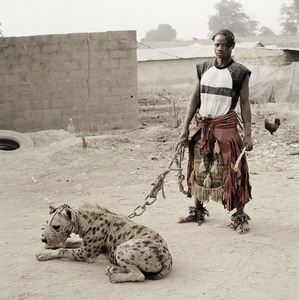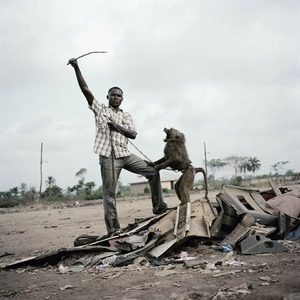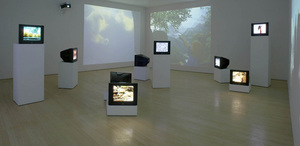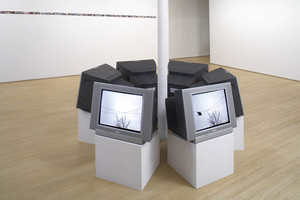This is an archive of the ArtCat Zine, 2007-2009. Please visit our new project, IDIOM.
Zoo Story: Recent Works By Nina Katchadourian and Pieter Hugo
Enrichment
Nina Katchadourian
Sara Metzer Gallery - 525-531 W. 25 St, New York NY
17 November - 22 December 2007
The Hyena and Other Men
Pieter Hugo
Yossi Milo Gallery - 525 W. 25 St, New York NY
29 November 2007 - 12 January 2008
In the summer of 1998, the prolific visual artist and musician Nina Katchadourian used red sewing thread to "repair" damaged spider webs on Porto, an island in the Finnish archipelago. She photographed these repairs immediately after making them, but discovered that the web tenants would overnight extricate her "patch jobs" and fix the web using their silk.
The "Mended Spiderweb" project is typical of Katchadourian's practice; wry humor and whimsy are integral, but an exuberant sense of wonder impels the work. The three works in "Enrichment," Katchadourian's current solo exhibition at Sara Meltzer Gallery, continue in this mode, though they also contemplate a somber side of humanity's relationship with the rest of the animal kingdom.
In Meltzer's upstairs gallery, Katchadourian has arranged wallet-sized pictures of animal species in a linear spectrum that transitions from incredibly cute, at the center, to "uncute," at either extreme. Initially, I thought "Continuum of Cute" worth only a chuckle, but as I reviewed Katchadourian's placement of the various species, I wised to the work's sly reproach. The "cute" animals are most often mammals with large, liquid eyes, those that conservation non-profits choose as their emblems, animation studios turn into cartoon protagonists, and children beg their parents to acquire as house pets. In this respect, Katchadourian's "Continuum of Cute" is not unlike a beauty pageant, but one in which the participants are not being judged by their own kind. The exhibition press release points out that "the entire spectrum is reconfigurable...and therefore hints at the subjective hand that each viewer would bring to" the task but, lest we forget, each of those hands is human.
Nearby, Katchadourian has arranged six televisions in a circle around an exposed, vertical pipe, each screen facing outward. When I ascended the gallery stairs, the two screens facing me were black. After several moments, however, the screen on the right lit up. I watched as an orangutan methodically crossed two suspended cables, moving from right to left. As the ape moved off the left edge of the frame, the next television screen was triggered and, on it, the same clip began anew. After the orangutan passed across the second monitor, he appeared on the third, and so on. Round and round the orangutan goes.
Most obviously, Fugitive is a melancholy commentary on the life of a caged animal. Enrichment, the title of the exhibition, refers to the environments, activities, and toys zoos provide for their animals to encourage behavior representative of each species and, hopefully, maintain the animals' psychological well-being. The climbing cables in this orangutan's enclosure are an example of enrichment, and Katchadourian's "double looping" of the footage highlights the existential difference between this orangutan's crossing of zoo cables and a wild orangutan's passage through the Indonesian jungle canopy. The former enterprise is essentially futile and Katchadourian smartly implicates viewers in the same existential absurdity; in order to follow the orangutan's "progress," we must shuffle around the ring of televisions in a similarly staggered orbit.
The central work in "Enrichment" is a 14-channel video installation entitled, simply, Zoo. Televisions and wall projections screen footage shot in eight different zoos over six years: an underwater sequence of a polar bear playing with its toys is projected onto a wall; perched atop a too-tall pedestal, a monitor shows a giraffe chewing; on another pedestal, this one stunted, a species of guinea fowl paces the Plexiglas wall of its enclosure, a behavior indicative of psychological stress. Other images are less clear: macro close-ups of animal plumage or fur, for example, or a swaying shot of zoo signage (a nod to another common displacement behavior).
Katchadourian's installation calls into question what exactly it is that we learn at the zoo. Proponents of zoos assert that people must be introduced to and educated about the species with which we share the planet before they will care about (and hopefully prioritize) wildlife conservation. The counter argument, however, insists that zoos reinforce the antique scalae naturae, or Great Chain of Being, by making explicit the separation between man and beast, implying man's superiority and eroding any precedent for conservation. As zoo proponents suggest, the modern zoo is an influential conservation organization; the care given contemporary zoo animals ranges from fair to excellent. Despite the occasional bad egg aside, most zoo keepers are diligent and devoted professionals with the best interests of both individuals and species in mind. Furthermore, educational signage continues to improve, making the zoo's educational goals more accessible and comprehensible to the casual zoo visitor.
But the over-arching moral and intellectual criticisms of the zoo need still be addressed. Derrick Jensen writes in his book, "Thought to Exist in the Wild: Awakening from the Nightmare of Zoos,"
"[Zoo visitors] learn that our world is limitless, and [the animals'] worlds limited, constrained. We learn that we are cleverer than they are... We learn that is is acceptable for the technologically powerful to confine the less technologically powerful. We learn that every one of us, no matter how powerless we may feel in our own lives, is more powerful than the most mighty elephant or polar bear.... We learn that you can remove a creature from her habitat and still have a creature... Zoos teach us implicitly that animals need to be managed, that they can't survive without us. They are our dependents; not our teachers, our neighbors, our betters, our equals, our friends, our gods. They are ours... We are here. They are there. We are special. We are separate."
Jensen is guilty of broad-stroke generalization, but he doesn't misrepresent the fundamental zoo experience. Judging by the ample laughter, shrieks, and window pound one might hear there, the zoo is above all an amusement park. Indeed, most zoo goers ignore the educational opportunities and instead look to our fellow animals for absolution. In this perverse dynamic, the exotic beasts piss, shit, feed, and fuck so that we can point and laugh at a cartoon expression of our own base biology. Katchadourian's installation is an accurate recreation of the zoo experience then: in a pristine gallery environment, we hear the sounds, we gawk at the frenetic, colorful and often abstract images, and we smile at the lounging lion's exposed belly.
A single monitor sits on a pedestal at the entrance to Katchadourian's installation. A brightly colored bouquet of animal balloons dominates the screen. These inflatable jaguars, lions, and toucans are contemporary totems, no less significant than the flesh-and-blood animals they represent.

© Pieter Hugo, Courtesy Yossi Milo Gallery
If asked, a child will tell you that she went to the zoo to "see the animals," but how much looking is really being done? In his 1980 essay, "Why Look At Animals?," artist and critic John Berger described the contemporary relationship (or lack thereof) between man and the other animals, focusing particularly on the "imperfectly-met gaze." Berger argues that humans possess animals by visual means; we look at them, but do not allow the animal to look back "across ignorance and fear." The human observing an animal through reinforced Plexiglas or bars objectifies the animal, reducing it to an icon. Berger writes, "the fact that [the animals] can observe us has lost all significance. They are the objects of our ever-extending knowledge. What we know about them is an index of our power, and thus an index of what separates us from them."
Pieter Hugo's striking photographs of African animal charmers posing with "domesticated" spotted hyenas, olive baboons, and pythons also evidence Berger's "index of power," though in an altogether different context. Far removed from first-world zoos, Hugo's subjects live in the arid, bone-bleached cities of northern Nigeria. Dominated by whites, browns and chalky yellows, the only saturated color in these handsome pictures is provided by the charmers' inherited American clothing, often branded with names of colleges or professional sports franchises.
Because the hyenas and baboons are chained, roped and muzzled, these "charmers" are more accurately dubbed handlers.

© Pieter Hugo, Courtesy Yossi Milo Gallery
In fact, Hugo's pictures force the viewer to question their own aesthete gaze and vantage point. The young Nigerian men are adorned similarly to their captives. The hyena handlers wear shackles for ankle or wrist bracelets and tie heavy knots to their clothes. The ornaments are presumably part of their street performer costumes but, in combination with their hand-me-down clothing and subjugated animals, these men seem victims of the global free-market's own Great Chain of Being, a hierarchy based not on "cuteness," but on humanity's ugly assumptions about social rank and economic worth.
Both artists' recent work reminds us that we are animals ourselves, and that our inadequate relationship with other species is reflected in our relationships with one another.
ZINE
HOME
TIPS / COMMENTS
CATEGORIES
CONTRIBUTORS
- Greg Afinogenov
- B. Blagojevic
- Adda Birnir
- Susannah Edelbaum
- Julie Fishkin
- Paddy Johnson
- Jessica Loudis
- Christopher Reiger
- Andrew Robinson
- Peter J. Russo
- Blythe Sheldon
- S.C.Squibb
- Hrag Vartanian


